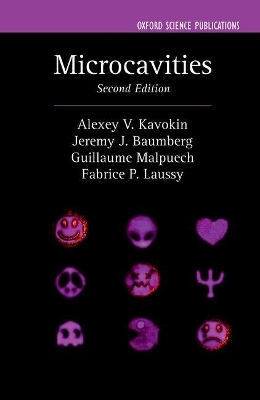
Microcavities
Oxford University Press (Verlag)
978-0-19-878299-5 (ISBN)
Microcavities are semiconductor, metal, or dielectric structures providing optical confinement in one, two or three dimensions. At the end of the 20th century, microcavities have attracted attention due to the discovery of a strong exciton-light coupling regime allowing for the formation of superposition light-matter quasiparticles: exciton-polaritons. In the following century several remarkable effects have been discovered in microcavities, including the Bose-Einstein condensation of exciton-polaritons, polariton lasing, superfluidity, optical spin Hall and spin Meissner effects, amongst other discoveries. Currently, polariton devices exploiting the bosonic stimulation effects at room temperature are being developed by laboratories across the world. This book addresses the physics of microcavities: from classical to quantum optics, from a Boltzmann gas to a superfluid. It provides the theoretical background needed for understanding the complex phenomena in coupled light-matter systems, and it presents a broad overview of experimental progress in the physics of microcavities.
Alexey Kavokin graduated from St-Petersburg Polytechnic University in 1992, PhD in Physics at the Ioffe Institute of Russian Academy of Sciences, 1993. In 1998-2005 he was a professor at the Blaise Pascal University, Clermont-Ferrand, France. Since 2005 he has been Professor and Chair of Nanophysics and Photonics at the University of Southampton, UK. Since 2010 he has been Scientific Director of the Mediterranean Institute of Fundamental Physics (Rome, Italy). He was Principal Investigator at the St-Petersburg State University (2011-2016), and since 2014 he has been Director of Research at the National Council for Research (Italy). Jeremy J. Baumberg FRS directs a UK Nano-Photonics Centre at the University of Cambridge and has extensive experience in developing optical materials structured on the nano-scale that can be assembled in large volume. He is also Director of the Cambridge Nano Doctoral Training Centre. Strong experience with Hitachi, IBM, his own spin-offs Mesophotonics and Base4, as well as strong industrial engagement give him a unique position to combine academic insight with industry application in a two-way flow. With over 15000 citations, he is a leading innovator in NanoScience. This has led to awards of the Royal Society Rumford Medal (2014), IoP Young Medal (2013), Royal Society Mullard Prize (2005), the IoP Charles Vernon Boys Medal (2000) and the IoP Mott Lectureship (2005). He frequently talks on NanoScience to the media, and is a strategic advisor on NanoTechnology to the UK Research Councils. Guillaume Malpuech received an engineering degree from École Centrale de Lyon in 1998, and a PhD in Physics from University Blaise Pascal (UBP) in 2001, Habilitation Thesis (2005). Between 2002-2012 he was a CNRS researcher at LASMEA -- Joint Unity of CNRS and UBP. Since 2005 he has been head of the group of Quantum Optoelectronics at LASMEA. Since 2012 he has been Senior CNRS researcher at the Institut Pascal, and since 2015 head of the Photon department of the institute. He is a known theoretician in the field of polaritonics with a large collaborative activity with leading experimental groups. He worked on polariton based optoelectronic devices, spinor quantum fluids of light, photonic analogues of cosmologic and solid state systems. F.P. Laussy is head of the quantum polaritonic group at the Universidad Autónoma de Madrid (Spain) where he leads the research efforts as the PI of various projects (POLAFLOW, SQUIRREL, CLAQUE). He graduated from Université Blaise Pascal in 2005, after which he obtained post-doc experience in Sheffield, Madrid and Southampton. He was a Marie Curie fellow at the Technische Universität München. He made seminal and pioneering descriptions of microcavity polaritons in their Bose-Einstein condensation, superfluidity, and superconductivity. His research groups recently proposed two new kinds of lights, one quantum -- a laser of N-photon states, emitting all its light in packets of N photons with tunable integer N, -- and the other classical -- Full-Poincaré temporal beams, or pulses of light taking all the states of polarization.
APPENDIX A: SCATTERING RATES OF POLARITON RELAXATION; APPENDIX B: DERIVATION OF THE LANDAU CRITERION OF SUPERFLUIDITY AND LANDAU FORMULA; APPENDIX C: LANDAU QUANTIZATION AND RENORMALIZATION OF RABI SPLITTING; INDEX
| Erscheinungsdatum | 17.05.2017 |
|---|---|
| Reihe/Serie | Series on Semiconductor Science and Technology ; 21 |
| Zusatzinfo | 239 b/w illustrations and 45 colour illustrations |
| Verlagsort | Oxford |
| Sprache | englisch |
| Maße | 174 x 236 mm |
| Gewicht | 1120 g |
| Themenwelt | Naturwissenschaften ► Physik / Astronomie ► Atom- / Kern- / Molekularphysik |
| Naturwissenschaften ► Physik / Astronomie ► Festkörperphysik | |
| Naturwissenschaften ► Physik / Astronomie ► Optik | |
| Technik ► Elektrotechnik / Energietechnik | |
| ISBN-10 | 0-19-878299-3 / 0198782993 |
| ISBN-13 | 978-0-19-878299-5 / 9780198782995 |
| Zustand | Neuware |
| Haben Sie eine Frage zum Produkt? |
aus dem Bereich


